We’d like to remind Forumites to please avoid political debate on the Forum.
This is to keep it a safe and useful space for MoneySaving discussions. Threads that are – or become – political in nature may be removed in line with the Forum’s rules. Thank you for your understanding.
The MSE Forum Team would like to wish you all a Merry Christmas. However, we know this time of year can be difficult for some. If you're struggling during the festive period, here's a list of organisations that might be able to help
📨 Have you signed up to the Forum's new Email Digest yet? Get a selection of trending threads sent straight to your inbox daily, weekly or monthly!
Has MSE helped you to save or reclaim money this year? Share your 2025 MoneySaving success stories!
I bought a Heat Pump
Comments
-
Wow, those pictures are completely different to my controls; much better in fact. I assume that they mean that the LWT will be 45 C if the outside temperature is -2 C or less and 30 C if the outside temperature is 21 C or more. My understanding of the AI mode is that it moves the whole line up and down so, based on the settings in your picture AI=-5 would set the target LWT at -2 outside down to 40 C and the target LWT at 21 C outside down to 25 C so the whole line between them moves down.
You could just fiddle with the high and low target temperatures but you should be able to do it more rigorously based on the information given to you by your MCS installer (if you had an MCS installer) and the type of heating you use (radiators or underfloor). Do you have documentation? And what outside temperatures are you experiencing at the moment?
My system was set up based on heat output calculations assuming: LWT was 50 C and the outside temperature was -3.8 C. On this basis my Weather compensation values are LWT = 50 C at -4 C or less outside. LWT = 29 C at 18 C or more outside. So at, for example at 7 C outside my target LWT would be 39.5 C (which is quite close to your value although it looks like your system was set up for larger area radiators than mine). My guess is that the changes you are making to the are not having much effect because those changes are only to the maximum target leaving water temperature and you need to change the max and min values, particularly if it's not yet that cold outside. But let's see if we can do this based on data, if you have some, rather than just trial and error.
Reed2 -
Firstly can I say that I really appreciate you taking the time to help me with this and thanks also for the explanation of the AI Mode changes which I wasn't aware of.As regards your questions:The Installers are MCS certified.I have radiators ("emitters"
 ) in each room. They apparently have a formula to work out the heat requirements for each room and the emitter size needed to get to that level, so some of the radiators had to be replaced as they weren't large enough. The new ones don't have TRVs because its a "whole of house" heating system.Last night (for various reasons) I was still up at 3am and the outside temperature was 3 degrees, but my upstairs room temperature was 23.9 and the downstairs was 22.5, so I decided to do something a bit drastic as mentioned above and changed the Target Temperature to 40 degrees to see what happens.Currently downstairs is 21.5 degrees and upstairs is now 23.1 degrees with an outside temperature of 7 degrees (the sun is shining on the ASHP unit, so may be warming it a little).I'm going to leave it as it is to see how things settle down as the forecast gives a maximum (shade) temperature of 6 degrees and 1 degree tonight.I've attached some more pictures of data from the system.There's an info sheet which gives details of the ASHP itself.The More Info page gives various temperature readings and the display on the right just scrolls between showing Water Pump Operation/ Outdoor Unit operation and Thermostat, but that's presumably just the operating modes and doesn't change anything on the main display.
) in each room. They apparently have a formula to work out the heat requirements for each room and the emitter size needed to get to that level, so some of the radiators had to be replaced as they weren't large enough. The new ones don't have TRVs because its a "whole of house" heating system.Last night (for various reasons) I was still up at 3am and the outside temperature was 3 degrees, but my upstairs room temperature was 23.9 and the downstairs was 22.5, so I decided to do something a bit drastic as mentioned above and changed the Target Temperature to 40 degrees to see what happens.Currently downstairs is 21.5 degrees and upstairs is now 23.1 degrees with an outside temperature of 7 degrees (the sun is shining on the ASHP unit, so may be warming it a little).I'm going to leave it as it is to see how things settle down as the forecast gives a maximum (shade) temperature of 6 degrees and 1 degree tonight.I've attached some more pictures of data from the system.There's an info sheet which gives details of the ASHP itself.The More Info page gives various temperature readings and the display on the right just scrolls between showing Water Pump Operation/ Outdoor Unit operation and Thermostat, but that's presumably just the operating modes and doesn't change anything on the main display.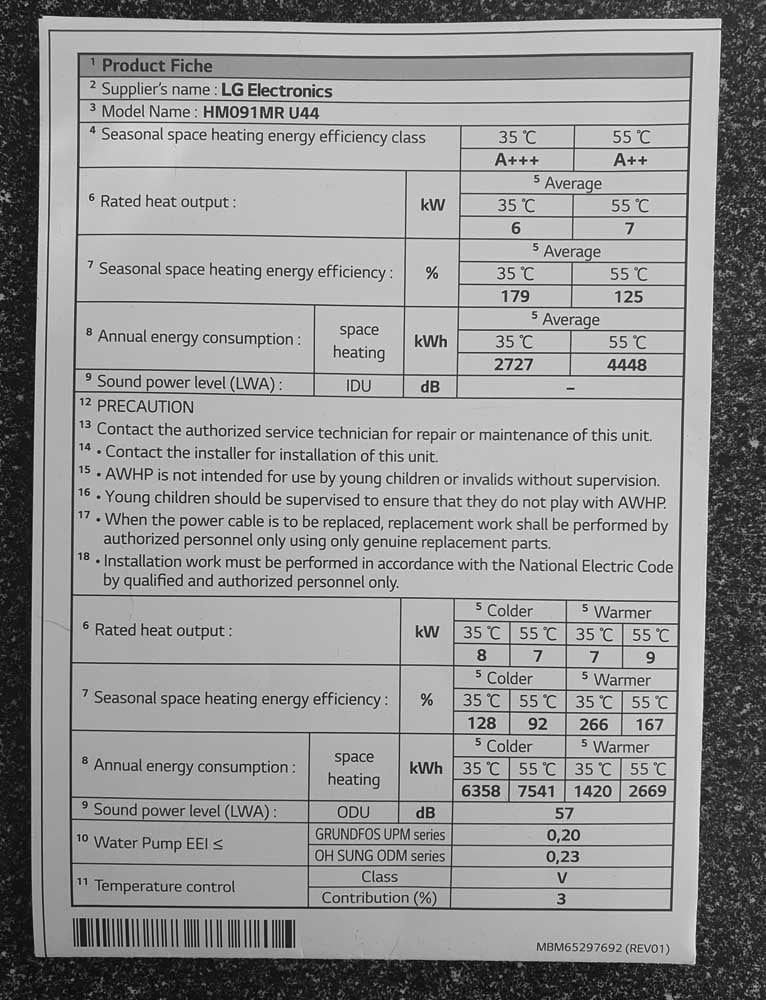
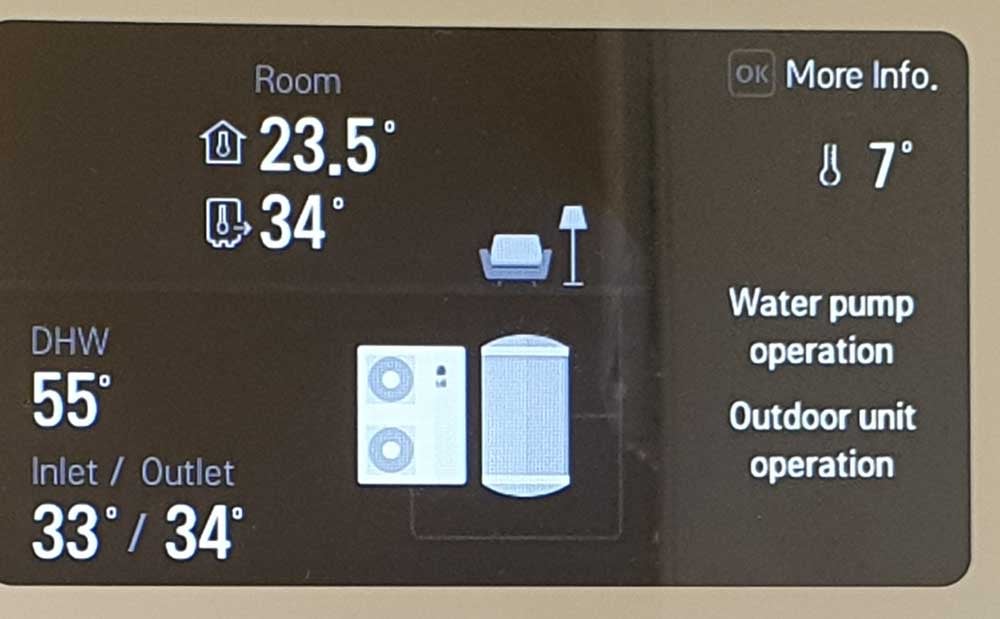
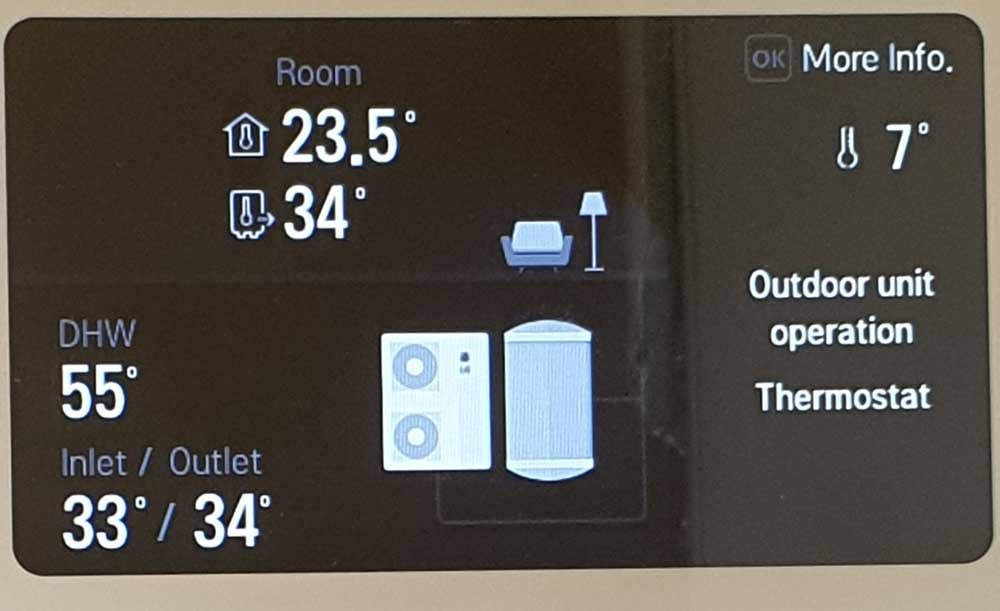 if i had known then what i know now0
if i had known then what i know now0 -
Nice display, updated since my model. Your unit must have just come on when you took the photo because the Leaving and Return water temperatures are almost the same. LWT = 34, room temperature is 23.5. Your DHW cylinder temperature is 55 C, which is higher than most people with a heat pump use. And it looks like the outside temperature is 7 C, my unit will not report the outside temperature so I'm a bit jealous.
You haven't told me how you know what the upstairs and downstairs temperatures are. That's quite important; are they part of how the heat pump is being controlled?
If you had reduced the Maximum target water temperature to 40 C then the LWT will be somewhere between 40 C and 30 C whatever the outdoor temperature. That's not a very big difference. If it gives you the downstairs temperature you want when its' 7 C outside then it's telling you that the LWT needs to be about 36 C for that outside temperature. And if your upstairs is hotter than your downstairs then you need to do the job your installer should have done and close the valves on your upstairs radiators cautiously and little-by-little until the temperature comes down to the same as downstairs (assuming that is what you want). That's not the TRV valves, where fitted, it's the ones at the other end. It's a very slow process because the temperature won't drop quickly. Maybe start with one turn clockwise on each radiator and see tomorrow if that has made any difference.
I can't make out anything useful from your info sheet. I would have expected your seasonal space heating efficiency to be 300% or more; perhaps those figures mean something different?Reed0 -
Reed_Richards said:You haven't told me how you know what the upstairs and downstairs temperatures are. That's quite important; are they part of how the heat pump is being controlled?
If you had reduced the Maximum target water temperature to 40 C then the LWT will be somewhere between 40 C and 30 C whatever the outdoor temperature. That's not a very big difference. If it gives you the downstairs temperature you want when its' 7 C outside then it's telling you that the LWT needs to be about 36 C for that outside temperature. And if your upstairs is hotter than your downstairs then you need to do the job your installer should have done and close the valves on your upstairs radiators cautiously and little-by-little until the temperature comes down to the same as downstairs (assuming that is what you want). That's not the TRV valves, where fitted, it's the ones at the other end. It's a very slow process because the temperature won't drop quickly. Maybe start with one turn clockwise on each radiator and see tomorrow if that has made any difference.
I can't make out anything useful from your info sheet. I would have expected your seasonal space heating efficiency to be 300% or more; perhaps those figures mean something different?I have two thermostats that show the temperature, one was from my old combi boiler (that stat is in the bathroom which is downstairs) the other is from the controller that came with the Pump which is upstairs in my bedroom/ office and I also have a workroom upstairs and there's no lounge/ sitting room downstairs, so I like the upstairs a bit warmer.The upstairs stat is in Manual Mode with a temperature setting of 24 degres, this was the one I set to 22 degrees to get the system to switch off when it was actually getting to 24 degrees up here. It's now reading 23.2 degrees after I set the Target Temperature to 40 degrees yesterday (The Installer said it should normally be set high enough that it shouldn't actually switch the system off when it's running properly.)Here's the latest pic.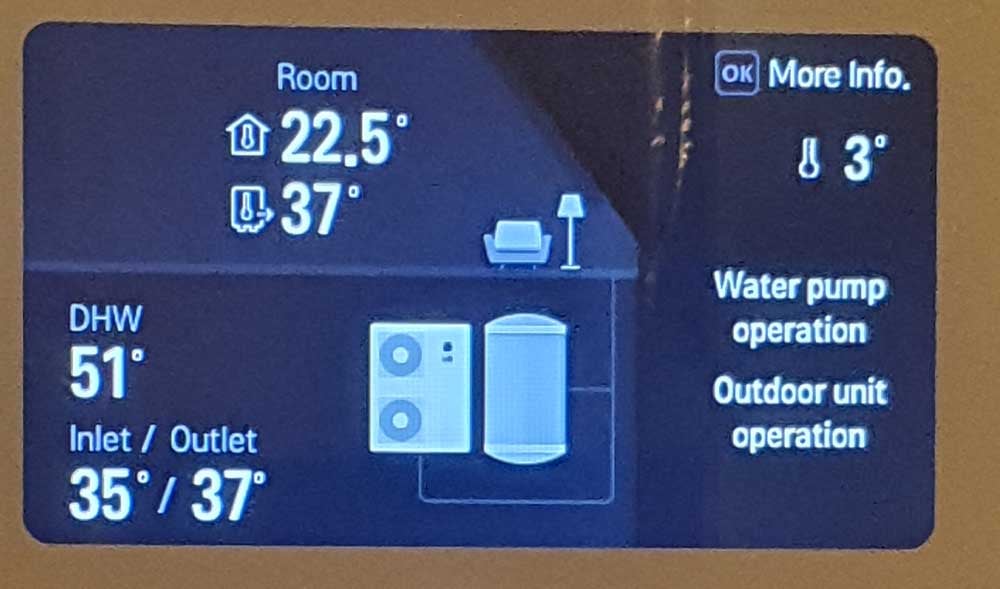 The Info Sheet was just something that came with the Pump, I have no idea what it refers to!if i had known then what i know now0
The Info Sheet was just something that came with the Pump, I have no idea what it refers to!if i had known then what i know now0 -
So the pictures are from the controller in your upstairs bedroom/office?
There are three control modes you can set, Water, Air + Water or Air. I think the instructions advise against using Air alone so I will ignore that last option. If the Controller actually controls your room temperature then I think you must be using Air + Water. This means if you set it at 24, as you had it originally, it will take the room temperature up to 24. If you set it at 22 it will take the room temperature up to 22 etc. etc. I'm not 100% sure about this because I use a third party thermostat/controller and I can only use Water control as a result
What your installer was aiming to achieve was Water control alone, you match the Leaving Water Temperture (LWT) to the outside air temperature so well, using Weather Compensation, that you don't need a room thermostat. It's quite ambitious because, as I mentioned in an earlier post, all kinds of external factors can mess it up. But, if I'm right, it looks as if your installer made a mistake with the settings.
So I think what you are doing at the moment is using Load Compensation to control the room temperature and that overrides your Weather Compensation. If this works well and it's not too mild out it should minimise any cycling your Heat Pump will do so it's a good thing - but you still need to optimise your Weather Compensation settings for best economy.
Can you please look at your settings and see if I am right, that the control mode is set to Air + Water. There's a long YouTube video that might help here https://www.youtube.com/watch?v=-OXFy2a14FE although it's for my older version of the controller. It goes through all the installer settings with a little bit of an explanation. I would not advise you to change any settings immediately and if you do feel tempted to make any changes do record what the setting was before you changed it. Reed0
https://www.youtube.com/watch?v=-OXFy2a14FE although it's for my older version of the controller. It goes through all the installer settings with a little bit of an explanation. I would not advise you to change any settings immediately and if you do feel tempted to make any changes do record what the setting was before you changed it. Reed0 -
Firstly the pictures above are from the controller next to the Dalek hot water tank in the kitchen.There's a separate remote controller in the bedroom which is currently set to Manual mode with a temperature of 24 degrees (it's showing the room temperature of 22.5 degrees in the picture).Following my changing the Target Temperature to 40, the bedroom temperature has dropped to between 22.1 and 22.5 degrees centigrade and the downstairs bathroom temperature has gone between 20.5 and 21 degrees. It's currently 22:30 and the outside temperature is 11 degrees.(Frankly those temperatures for downstairs and upstairs are acceptable, so I probably won't play around with the settings any more unless they suddenly start getting hotter or colder.)The downstairs controller is set to Water, I checked and there are alternative settings eg Air + Water, but it's only showing Water. The Remote Control bit is ghosted out, but if I changed the setting to Air + Water it was selectable again (I then changed it back to Water).When the room temperature was getting up to almost 24 degrees and I set the Thermostat to 22 degrees, the heating did shut off if the room temperature got to that level. If I actually take part in the Demand Flexibility Scheme, this is what I'm thinking of doing by dropping the Thermostat to eg 18 degrees for the DFS hour.BTW the Installer mentioned about "cycling" being a bad thing, but he didn't really explain it and I'm still not sure what it means, so if you can clarify that, it would be very helpful.A couple of other things: under Room Heating "Heating Temp Setting" is "Outlet".There's also a chart marked "Data Logging" which I guess shows the temperature in the radiators or in the hot water tank.
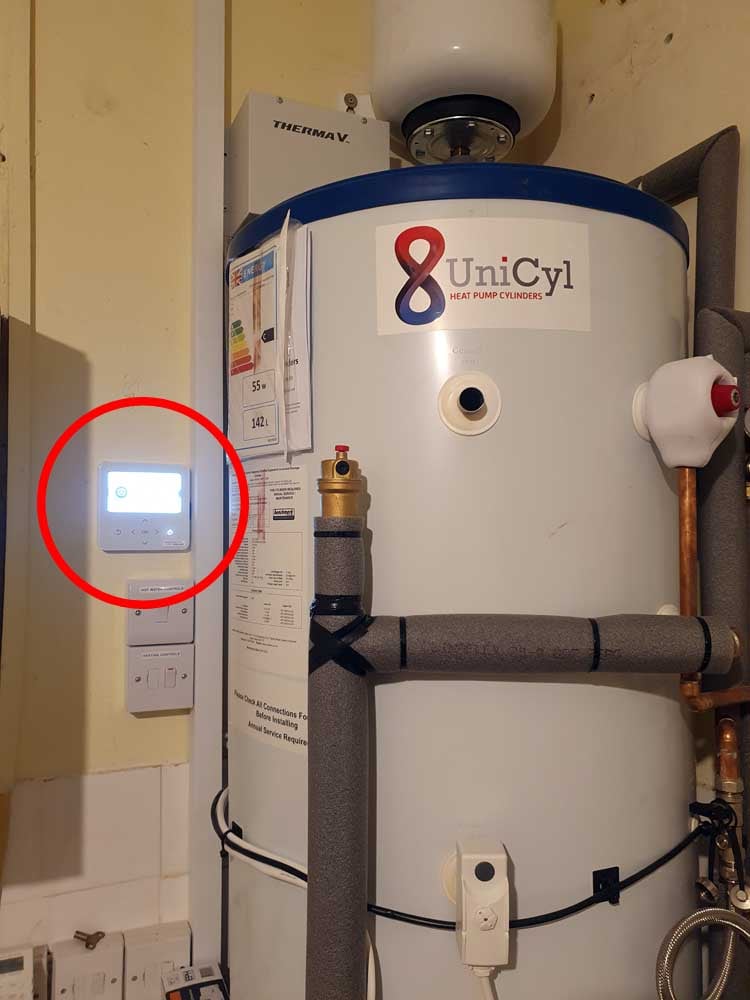

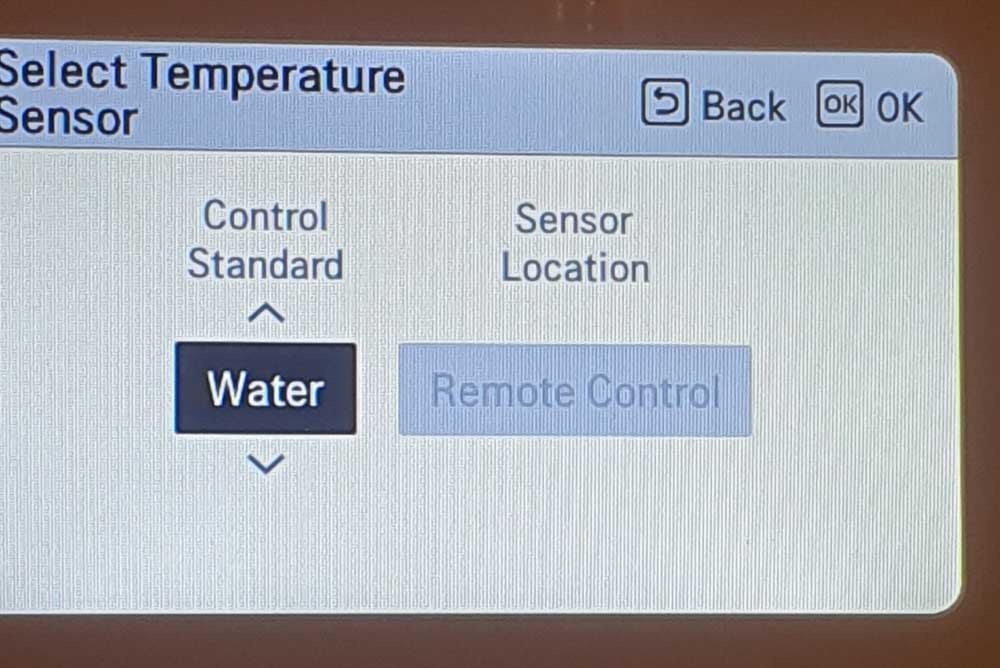
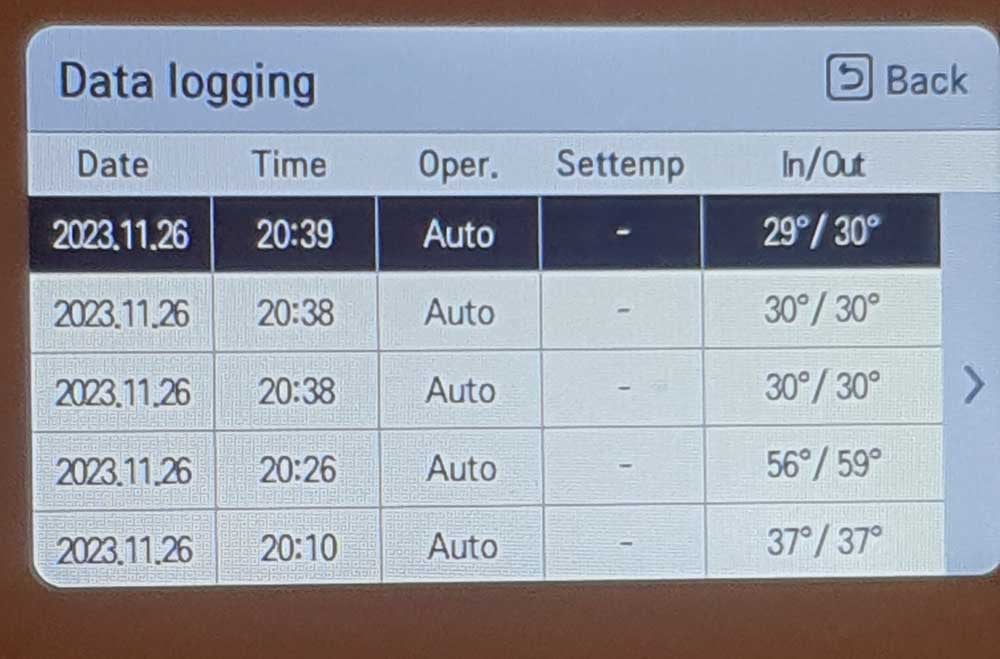
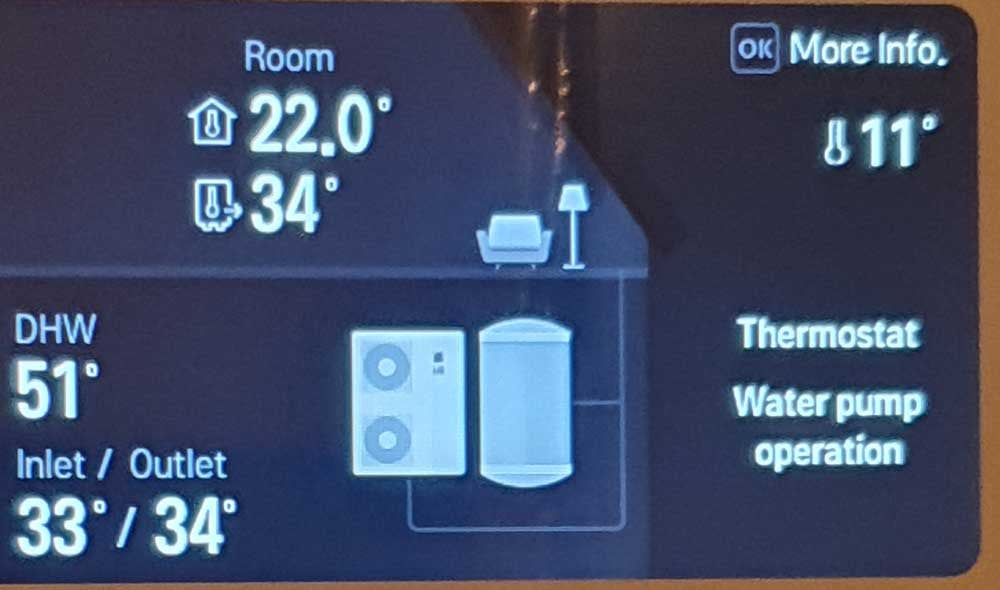 if i had known then what i know now0
if i had known then what i know now0 -
I don't recognise the picture of your "remote controller" in the bedroom. It doesn't look like it's an LG product; is there anything written on it to indicate the manufacturer? A Google Image search suggests it is an EPH Programmable Thermostat. If that's correct it must be communicating with another control box somewhere, perhaps out of shot in your cylinder cupboard?
All heating systems cycle when it is so mild outside that the amount of heat needed to keep the house warm is less than the heat output from your heat source, that is your boiler or heat pump. There is nothing wrong with cycling but if the cycle times are very short then that can cause a heating system to run inefficiently and can increase the rate at which components wear out. So the potential problem is "short cycling". I think this is worse for boilers than for heat pumps because the boiler does not reach its optimum combustion temperature if the cycle times are too short. When my heat pump cycles, my controller does not allow it to make more than 3 cycles per hour and I'm confident that is fine. But if the cycles only last for a couple of minutes that's probably too short.Reed0 -
There's a label on thermostat from ATAG Heating Technology https://www.atagheating.co.uk/ however there's a QR code that takes me to a YouTube video on how to use an EPH CP4 [bunch of other codes] programable thermostat.But it's not used as a programable thermostat, it's literally just a remote on/ off switch that will turn off the Pump if the temperature gets above the level that's set in Manual Mode.After I'd had the Pump installed, the weather was warm enough that I didn't need the heating running, so the temperature was set to 16 degrees.When it started getting colder, I set it to 24 degrees to switch the system on (although the design was that it should only run up to about 21 degrees, based on the sizes of the radiators and the estimated heat loss of the house).Thanks for the explanation about the pump cycling, I think I get it now.
if i had known then what i know now0 -
Perhaps I could have been even clearer about cycling. A boiler or a heat pump will run until its return water gets too hot ("too" being determined by some internal setting) at which point it will cut out whilst the water cools for a bit. After that your heat source will come back on and the cycle repeats, usually at quite regular intervals. A heat pump or a gas boiler can modulate its output down to try to prevent the return water from overheating. But if the weather is mild enough outside it won't be able to modulate down enough and cycling is inevitable.
Many modern heating controllers can prevent short cycling by setting a maximum number of cycles per hour or a minimum "burn" time. Unfortunately this is not a feature of your Atag-badged EPH controller, as best as I can tell.
So I now understand that your heat pump is controlled by a "Third Party Controller", that is not one made and supplied by the heat pump manufacturer, LG. Your LG controller is in a warm room next to your DHW cylinder so must be used for Water control only. Forget that I mentioned Air + Water, that could only ever possibly be used if the LG controller was in a room with radiators.
So, your heat pump is controlled by the thermostat in your bedroom. Set it at 24 C and the heat pump will try to make your bedroom 24 C. Set it at 22 and it will try to make your bedroom 22. You can program different temperatures at different times but you have it set to manual and that gives you the same temperature all the time. Or it will try to do that and it will succeed provided your Leaving Water Temperature is hot enough. If the LWT is too cold your bedroom will never reach the set temperature. If the LWT is hotter than it needs to be then your heat pump could cycle and if it's a lot hotter than it needs to be those cycles may be quite short.
The temperature that your LWT needs to be depends on how much heat your house needs, which depends mostly on how cold it is outside (although other factors can have a lesser influence). An ideal Weather Compensation curve matches the LWT to the outside temperature so you always have just enough heat to keep your bedroom warm.
So, where you are now is that you have set the temperature in your bedroom to what you want it to be. It's on "manual" so it maintains that temperature 24/7.
Stage 1. Now check every other room in the house and check that they are also at the temperature you want them to be. If a room is too hot you need to reduce the water flow by tightening the radiator valve (but remember that any response will be very slow). If a room is too cold see if the radiator valves are fully open (if not things get a bit more involved). Eventually you will get every radiator in the house balanced, if this has not already been done.
Stage 2. You try to find the ideal Weather Compensation setting. This will take time because you need to explore what happens over a wide range of outside temperatures. All you know at the moment is that your LWT is still hot enough to keep your bedroom at the temperature you want it to be. If you can find any more information on how your radiators were sized that would be very helpful.
Please continue to update us with how you are getting on.
Reed1 -
Sorry if this gets a tad too long in advance!My experience on the installation of my ASHP.Installed in June. In November, the pump started to kick in and heat the home. Radiators nearest the pump heated up first and those furthest away were barely warming up at all. There was an 8 degree difference in room temperatures. By chance the first radiators in the system were upstairs bedrooms and then the bathroom and then the water would move on to downstairs rooms such as the living room where the room stat was.So little heated water was reaching the living room where the room stat was the upstairs rooms were overheating (For Me!) The heating system could never warm up the living room to the target temp (18) and the bedrooms were 24+!Moving the room stat upstairs!! wasn't the answer, i would freeze to death downstairs!So i had to start by doing what we/i would traditionally do.... balance the radiators, so the heated water in the pipework would be forced to move on to the radiators furthest from the pump in the system. Getting this somewhere even takes time and patience and can take a good few hours, even a couple of days of tweaking. But it is a simple process.I now had a heating system that was heating up the home evenly throughout........... but warm heated air rises in any given space such as a home and heated air downstairs was making it's way upstairs and upstairs rooms were still (For Me) over heating. I could no longer restrict water flow to the upstairs radiators because i had already turned the valves so far that they were only open by 1/8th of a turn! So by using the TRV's i could turn them down/off when the room temp was satisfactory to me. My main bedroom radiator rarely warms up and never for very long now (i would never get to sleep otherwise). Birthday suit only without any duvet or bedding of any kind!!!!!!!!!!!!!! Even now in winter there are nights when i have to open upstairs windows because it's far too warm for me.I have Weather Compensation enabled and i haven't tinkered with any advanced settings yet.I do have a secondary heat source for two reasons, firstly because i/we do like a real fire (Multi Fuel Stove) and secondly because i do suffer frequent power cuts.Using the stove on occasional weekends, xmas and new year etc and when i have guests or a prolonged power cut, the pump simply stops doing it's job and as the house cools down over the following couple of days the pump starts doing it's job again, sporadically at first and then more often as the house cools down, but it doesn't seem to be consuming any more electricity than it would do normally.I have a low cost, comfortable, evenly heated house using lazy, simplistic controls (Room Stat and TVR's) without exploring advanced controls.Solutions to problems (Any Problem) needn't be difficult nor complicated, most of the time.0
Confirm your email address to Create Threads and Reply

Categories
- All Categories
- 352.9K Banking & Borrowing
- 253.9K Reduce Debt & Boost Income
- 454.7K Spending & Discounts
- 246K Work, Benefits & Business
- 602.1K Mortgages, Homes & Bills
- 177.8K Life & Family
- 259.9K Travel & Transport
- 1.5M Hobbies & Leisure
- 16K Discuss & Feedback
- 37.7K Read-Only Boards





